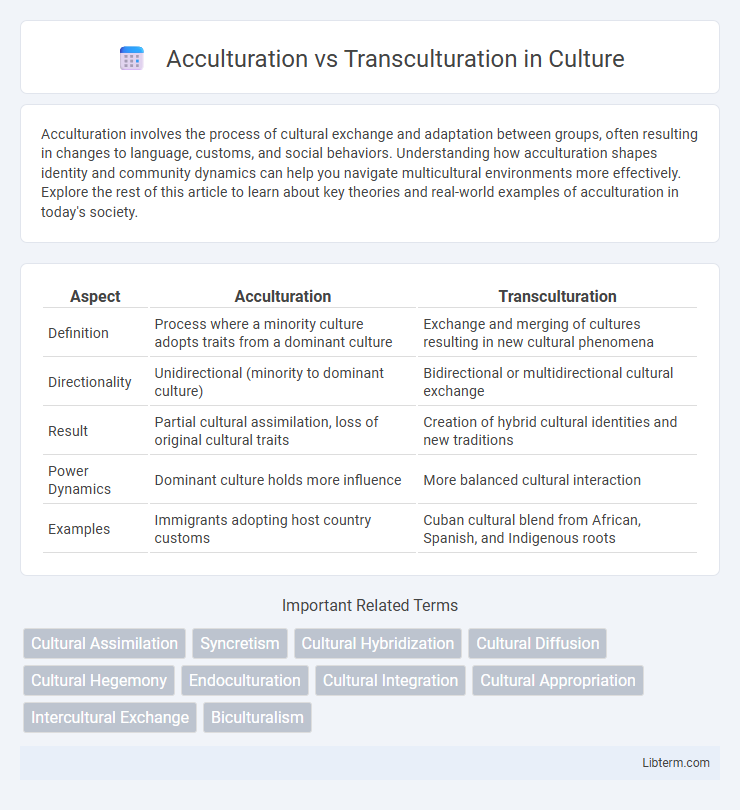Acculturation involves the process of cultural exchange and adaptation between groups, often resulting in changes to language, customs, and social behaviors. Understanding how acculturation shapes identity and community dynamics can help you navigate multicultural environments more effectively. Explore the rest of this article to learn about key theories and real-world examples of acculturation in today's society.
Table of Comparison
| Aspect | Acculturation | Transculturation |
|---|---|---|
| Definition | Process where a minority culture adopts traits from a dominant culture | Exchange and merging of cultures resulting in new cultural phenomena |
| Directionality | Unidirectional (minority to dominant culture) | Bidirectional or multidirectional cultural exchange |
| Result | Partial cultural assimilation, loss of original cultural traits | Creation of hybrid cultural identities and new traditions |
| Power Dynamics | Dominant culture holds more influence | More balanced cultural interaction |
| Examples | Immigrants adopting host country customs | Cuban cultural blend from African, Spanish, and Indigenous roots |
Understanding Acculturation: Definition and Key Concepts
Acculturation refers to the process through which individuals or groups adopt elements of another culture, often occurring when different societies come into continuous first-hand contact. Key concepts include cultural assimilation, integration, and adaptation, highlighting changes in language, customs, values, and social behaviors. Understanding acculturation involves recognizing its dynamic nature, as it impacts identity formation and intercultural communication within multicultural contexts.
Exploring Transculturation: Meaning and Features
Transculturation refers to the complex process of cultural transformation that occurs when different cultures interact, resulting in the creation of new cultural phenomena rather than a one-sided assimilation. Key features include bi-directional exchange, hybridization of traditions, and the emergence of novel identities that blend elements from multiple cultures. Unlike acculturation, which often implies a dominant culture influencing a subordinate one, transculturation emphasizes mutual influence and the dynamic, ongoing evolution of cultural practices.
Historical Roots: Evolution of Acculturation and Transculturation
Acculturation traces its roots to early 20th-century anthropology, where scholars examined cultural changes resulting from prolonged contact between dominant and subordinate groups, typically within colonial contexts. In contrast, transculturation emerged from Cuban sociologist Fernando Ortiz's mid-20th-century work, highlighting the complex, reciprocal cultural exchanges that produce entirely new cultural phenomena rather than one-sided assimilation. These historical perspectives underscore acculturation's focus on adaptation and loss, while transculturation emphasizes synthesis and cultural innovation in multicultural encounters.
Key Differences Between Acculturation and Transculturation
Acculturation involves the gradual adoption of cultural traits from a dominant culture by a minority group, often resulting in partial cultural change while maintaining core aspects of the original culture. Transculturation, on the other hand, refers to a more dynamic and reciprocal exchange where two or more cultures merge to create new cultural phenomena, emphasizing mutual influence and synthesis. Key differences include the unilateral assimilation process in acculturation versus the bidirectional cultural transformation inherent in transculturation.
Models and Theories of Cultural Exchange
Acculturation models emphasize the adaptation process where individuals adopt traits from a dominant culture while retaining aspects of their original culture, often described through Berry's bidimensional model categorizing integration, assimilation, separation, and marginalization. Transculturation theories focus on the dynamic, reciprocal exchange of cultural elements leading to the creation of new cultural phenomena, highlighting concepts by Fernando Ortiz on cultural hybridity and syncretism. Both frameworks contribute to understanding cultural exchange but differ in their portrayal of power dynamics and the outcomes of cultural interactions.
Impact on Identity: Personal and Collective Perspectives
Acculturation affects identity by blending elements of one culture into another, often leading to changes in personal beliefs and collective cultural norms while maintaining a dominant culture's framework. Transculturation involves a two-way exchange where new, hybrid identities emerge, reflecting both personal and collective transformation without erasing original cultural identities. This dynamic process fosters a complex interplay of adaptation and preservation that reshapes individual self-concepts and community cohesion.
Acculturation in Immigrant Communities
Acculturation in immigrant communities involves the process by which individuals adopt the cultural traits or social patterns of the host society while retaining elements of their original culture. This phenomenon is characterized by language adaptation, changes in dietary habits, and shifts in social norms, impacting identity and community cohesion. Research shows that successful acculturation promotes better psychological well-being and socio-economic integration among immigrants.
Transculturation in Globalization and Hybridization
Transculturation represents a dynamic process within globalization, where cultures merge and create hybrid identities rather than one dominating the other, fostering mutual influences and innovations. It captures the synthesis of cultural elements from different societies, leading to new, hybrid cultural forms that transcend simple assimilation or acculturation. This phenomenon drives globalization by promoting cultural diversity, dialogue, and hybridization, enabling societies to form complex, interconnected cultural landscapes.
Challenges and Opportunities in Cultural Transformation
Acculturation presents challenges such as identity loss and cultural homogenization, yet offers opportunities for social integration and mutual understanding. Transculturation involves complex cultural exchanges that can create hybrid identities, fostering innovation and enriched cultural expressions but also risking cultural tensions. Navigating these processes requires balancing preservation of heritage with openness to transformation, enabling dynamic cultural evolution.
Future Trends in Cultural Integration and Exchange
Future trends in cultural integration emphasize transculturation as a dynamic, reciprocal exchange fostering hybrid identities rather than one-sided acculturation. Digital globalization accelerates transcultural dialogues, enabling diverse communities to co-create shared cultural expressions and innovations. Emerging technologies and increased intercultural collaboration predict a shift towards more complex, multifaceted cultural syntheses shaping global society.
Acculturation Infographic

 libterm.com
libterm.com